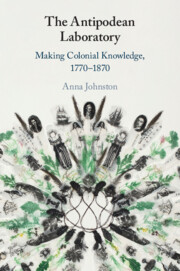Book contents
- The Antipodean Laboratory
- The Antipodean Laboratory
- Copyright page
- Dedication
- Contents
- Figures
- Acknowledgements
- Note on the Text
- Introduction
- Part I Imagining Settler Humanitarianism
- Part II Regulating Settler Society
- Part III Inventing Settler Science
- 5 Collecting Practices
- 6 Creating Colonial Readers and Imperial Networks
- Conclusion
- Bibliography
- Index
6 - Creating Colonial Readers and Imperial Networks
The Tasmanian Journal of Natural Science, 1841–1849
from Part III - Inventing Settler Science
Published online by Cambridge University Press: 21 September 2023
- The Antipodean Laboratory
- The Antipodean Laboratory
- Copyright page
- Dedication
- Contents
- Figures
- Acknowledgements
- Note on the Text
- Introduction
- Part I Imagining Settler Humanitarianism
- Part II Regulating Settler Society
- Part III Inventing Settler Science
- 5 Collecting Practices
- 6 Creating Colonial Readers and Imperial Networks
- Conclusion
- Bibliography
- Index
Summary
This chapter analyses the Tasmanian Journal of Natural Science (1841–1849), the first Australian scientific periodical. Although Lieutenant-Governor John Franklin was the journal’s patron, Jane Franklin used the Tasmanian Journal to pursue her interests in botanical science, domestic experiments with Indigenous children and educational reform. The Tasmanian Journal was a material record of the Franklins’ efforts to use science and education to change colonial culture. It reveals the scientific endeavours undertaken by local collectors and visiting scientists, and provides an insight into the scissors-and-paste construction of periodical publications. Notable contributors included the scientist and explorer Paul Strzelecki, the New Zealand missionary botanist William Colenso, the ornithologist John Gould and Dr Edmund Hobson who studied the platypus and, with his wife Margaret, identified marsupial megafauna fossils. Local collectors used science to further their social status, and local elites used scientific print culture to further their political and intellectual interests. Colonial and imperial politics intersected with scientific print culture, in which race, gender and knowledge played complicated roles. Alongside the scientific journal, colonial newspapers and Indigenous letter writers and petitioners from Flinders Island used Tasmania’s distinctive print culture to raise pressing questions about colonial governance, Indigenous welfare and the settler colonial public sphere.
Keywords
- Type
- Chapter
- Information
- The Antipodean LaboratoryMaking Colonial Knowledge, 1770–1870, pp. 212 - 246Publisher: Cambridge University PressPrint publication year: 2023



